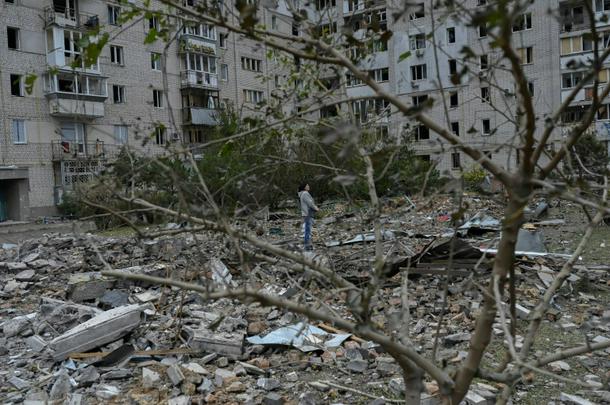
The Battle for Kherson will rely on a ragtag army of committed but outgunned reservists
ROAD TO KHERSON (Ukraine) (AFP) - The two old friends worked as truck drivers before picking up assault rifles. Their commander was an office manager.
None of them expected to be sitting in a trench near an exposed road leading to Russian-occupied Kherson – the new target of Ukraine’s month-long counteroffensive.
All three would hate to admit that the next phase of a war posing the gravest threat to global security in generations depended on the fighting spirits of men like themselves.
And each one would dearly love to go home.
“The conditions here are not great,” truck driver-turned-grunt soldier who goes by “Uncle” said after ending up on the front lines of the battle for Kherson.
“We go up this road under fire and come back down this road under fire,” the 51-year-old grumbled with a mischievous twinkle in his eye.
The wilted sunflower fields around him offered nowhere to hide from the Russian bombs and missiles that the men were expecting to start falling any minute.

Russia seized Kherson in the first weeks of war, establishing a land link with Crimea
They had just finished firing their own artillery guns and were bracing for the almost inevitable response.
His younger friend Znakhar glanced down at his dirty boots and resorted to the gallows humour befitting such situations.
“At least we have bigger trenches here. The ones we dig out there are individual-size holes in the ground,” he said with a nod toward the battles raging a few fields closer to Kherson.
“We call them our personal graves.”
- Exposed -
A 25-mile (40-kilometre) road running from government-held Mykolaiv to Russian-occupied Kherson will form the backbone of Ukraine’s push to regain access to the Sea of Azov and cut Russia’s land link with Crimea.
The Ukrainians were advancing from two directions toward the only regional capital the Russians have been able to seize in the entire war.

The Russians continue to pummel Mykolaiv to stall Ukraine's advance toward Kherson
The substantially longer route runs down from the steel-producing city of Kryvyi Rig and passes a web of villages – most still under Russian control.
The shortcut takes the M14 highway directly into Kherson.
The campaign was being spearheaded by elite units and supported by a ragtag army of volunteers who shuttle up and down the two-lane road with almost no protection from Russian drones and warplanes.
Many curse and grumble along the way.
- Pride -
The truckers’ commander is a slight and scholarly-looking man who worked in an office and had no fighting experience prior to Russia’s invasion.

US Deliveries of long-range missiles swung the course of the war in Ukraine's favour
His eyes turn moist with emotion recalling the outpouring of support his unit gets from the few Ukrainians who have still not fled the surrounding devastation.
“They give us fruit, vegetables – it’s not like we even need all this stuff,” commander Mykhailo said with a shy smile.
“It’s nice. It’s nice to think that your neighbours, friends, their children, that they are all behind you,” the 41-year-old said.
“Everyone wants to help anyway they can.”
But his face turns stoney when he starts listing all the weapons Ukraine still needs to finally push out the Russians.
“It is very hard to fight tanks with automatic rifles,” he said.
- Underdogs -
Mykhailo ran out of fingers counting the weapons his units need to fight without exposing themselves to return fire – a frustration that has lingered since the first days of war.
Washington’s decision in late May to start supplying long-range missiles changed the counters of the war and allowed the Ukrainians to launch their counter-offensive across the north.
But the retreating Russians have poured most of their remaining strength into making sure they hold onto Kherson.

Ukrainian commander Andre scoffs at Russia's ability to wage a modern war
A loss there would leave Russian President Vladimir Putin with little more than the blood-soaked ruins of Mariupol and the eastern lands his proxy forces seized in 2014.
Senior commander Andre – a veteran of the simmering conflict Ukraine endured prior to Putin’s all-out invasion – seemed to relish his troops’ underdog status.
He strode down a field littered with the charred remains of a Russian battalion that tried to capture Mykolaiv in the first 10 days of war.
It reached its edge before being wiped out by Ukrainian volunteers who fired at the Russians from surrounding rooftops.
“They still follow their Soviet military training,” the 50-year-old soldier said.
“Actually, their textbooks must date back World War I,” he scoffed. “There is no other way of understanding how they fight.”